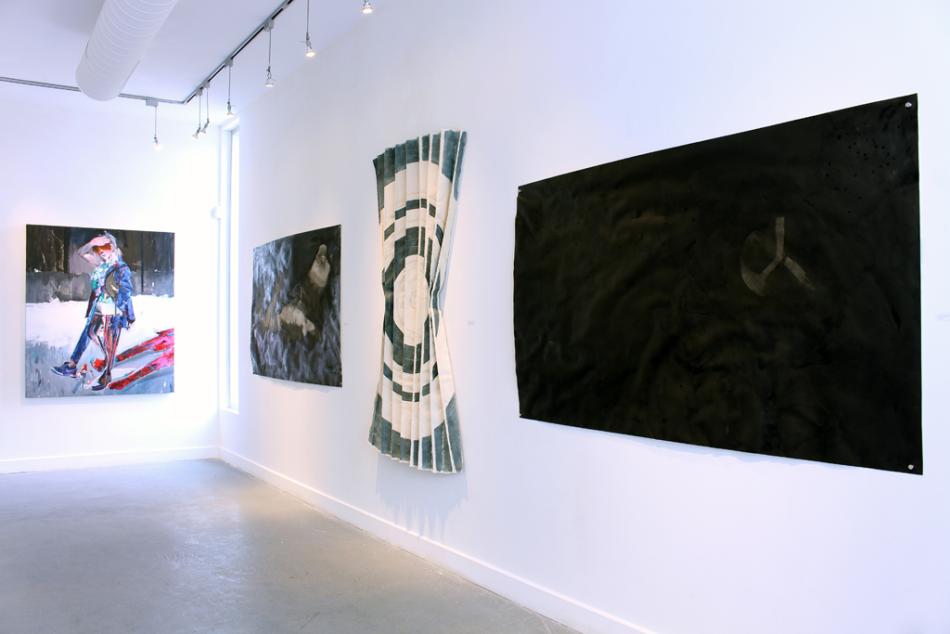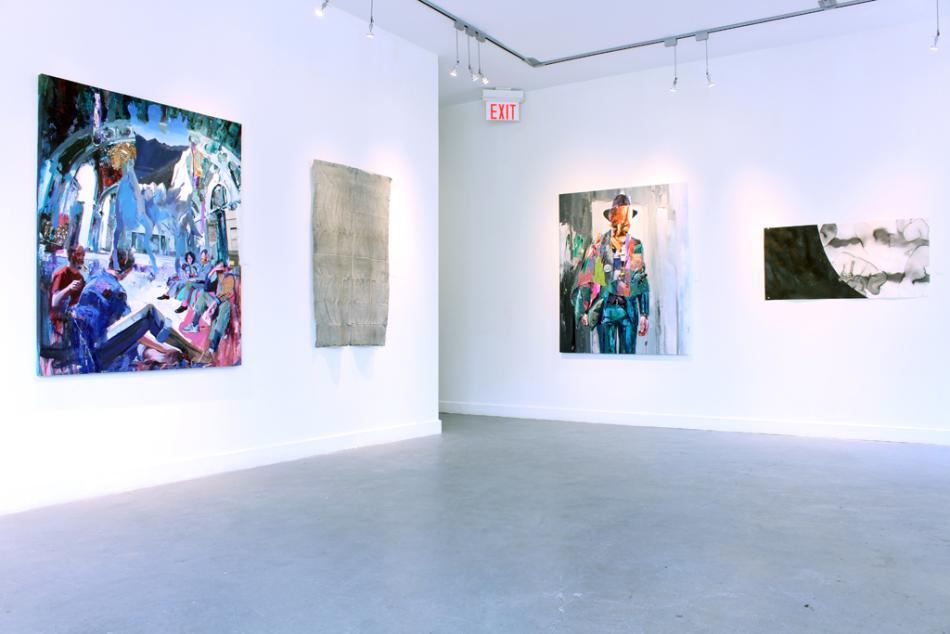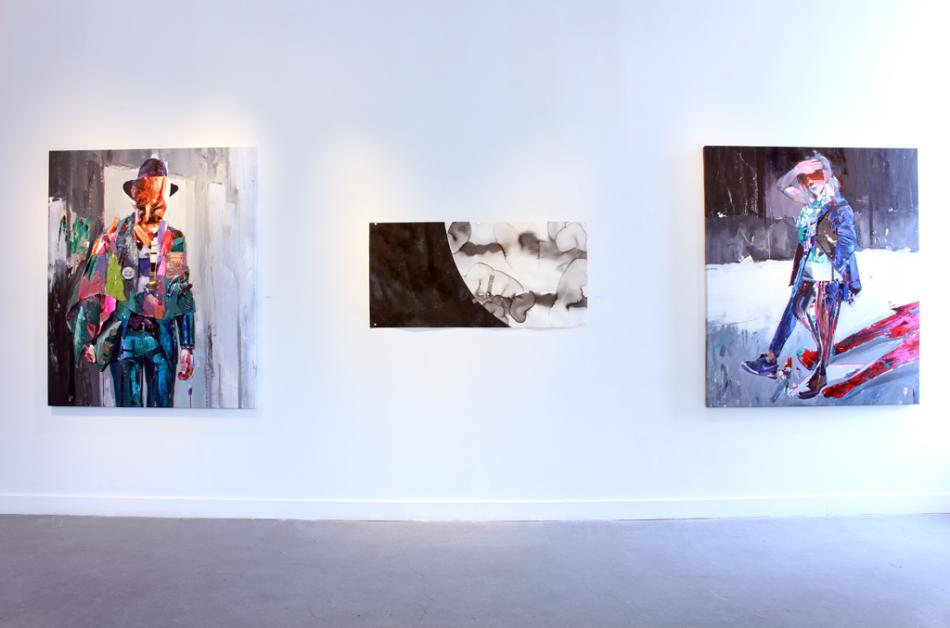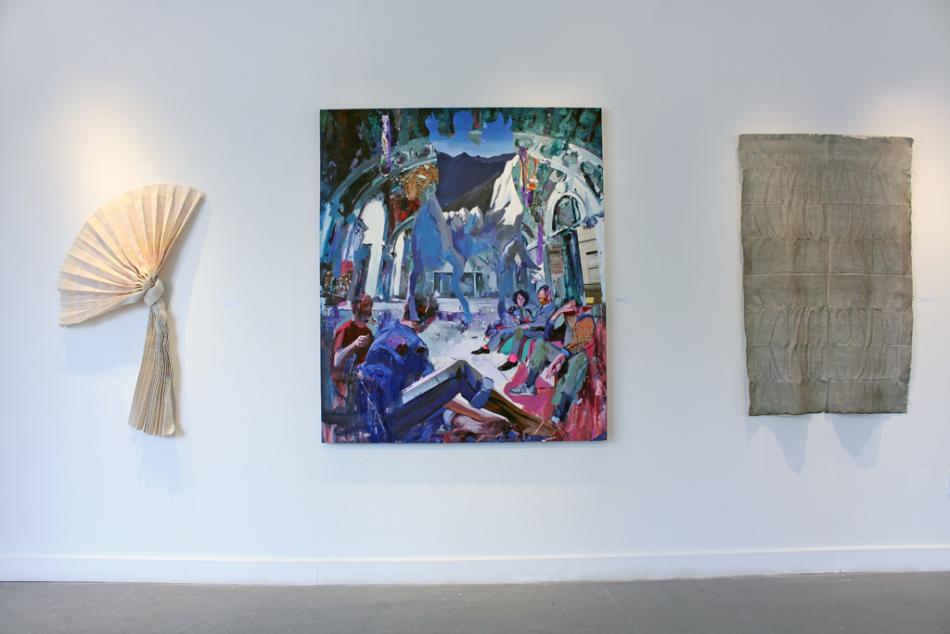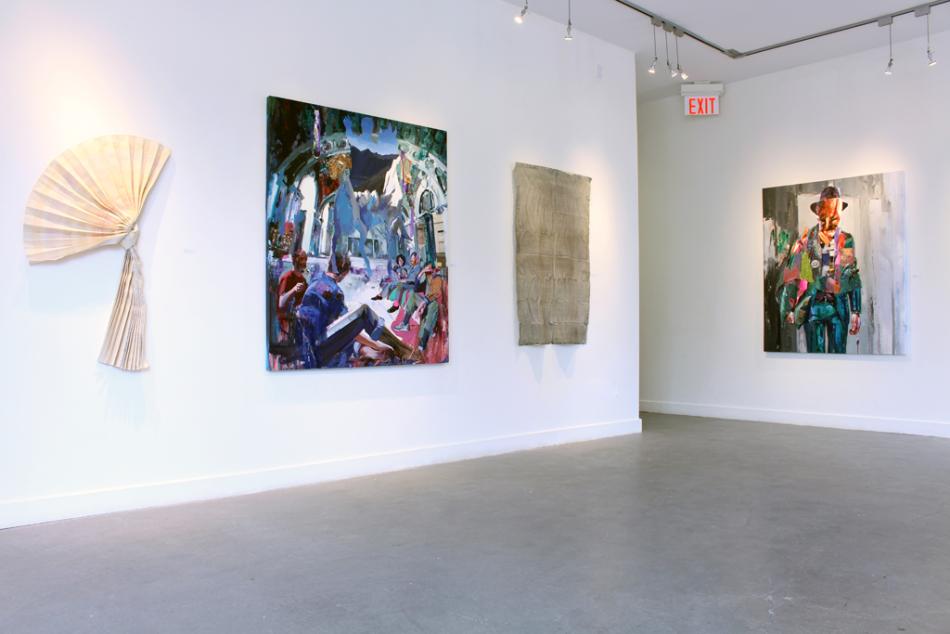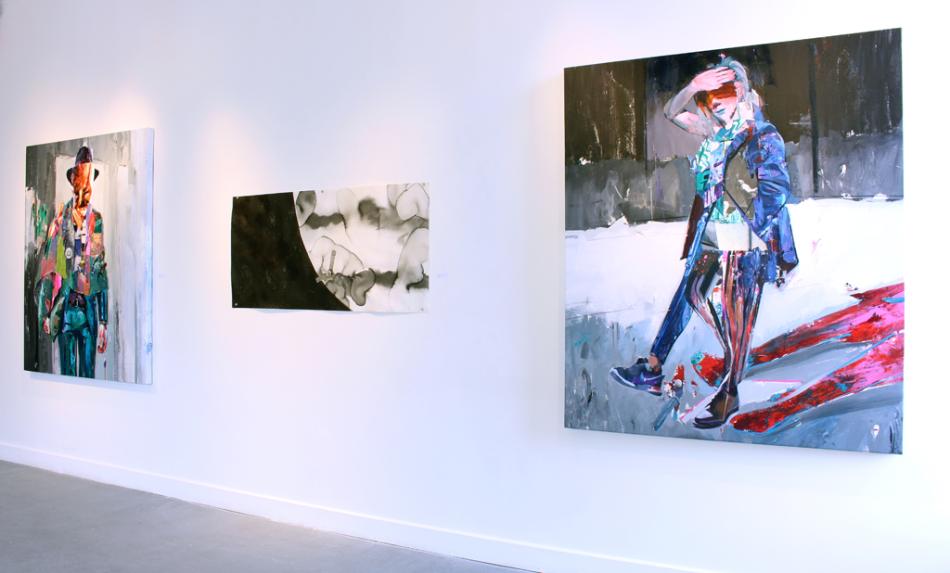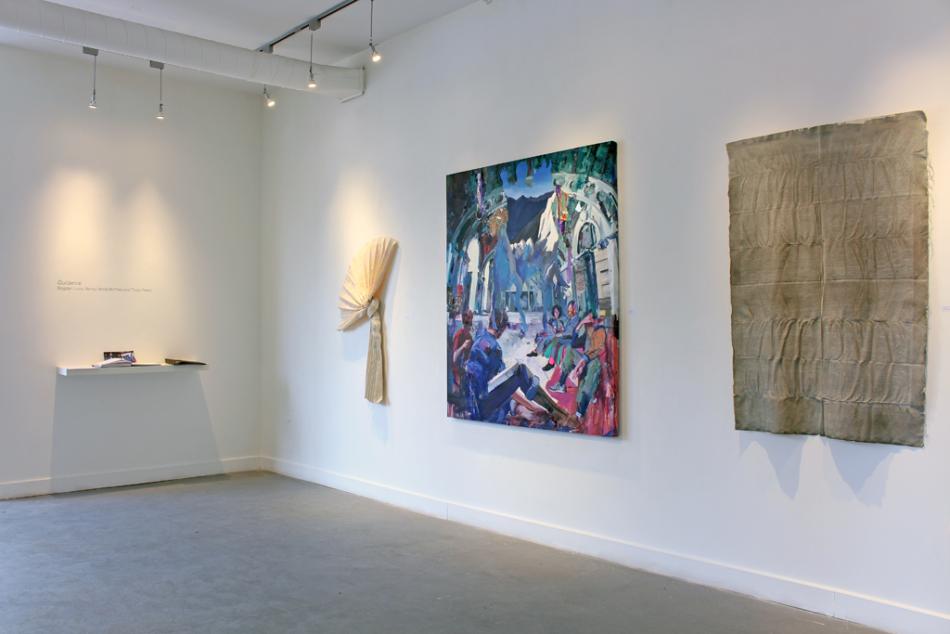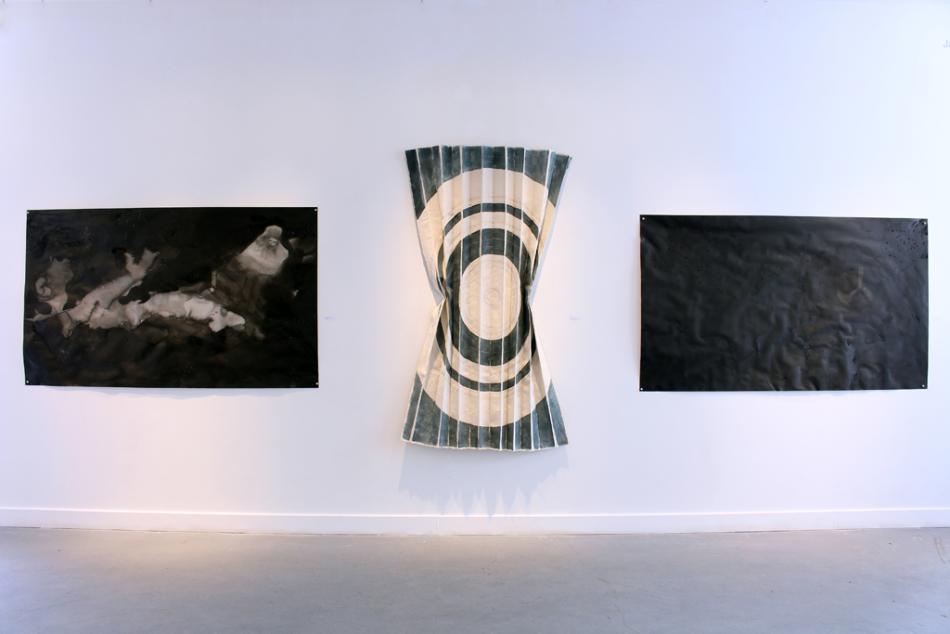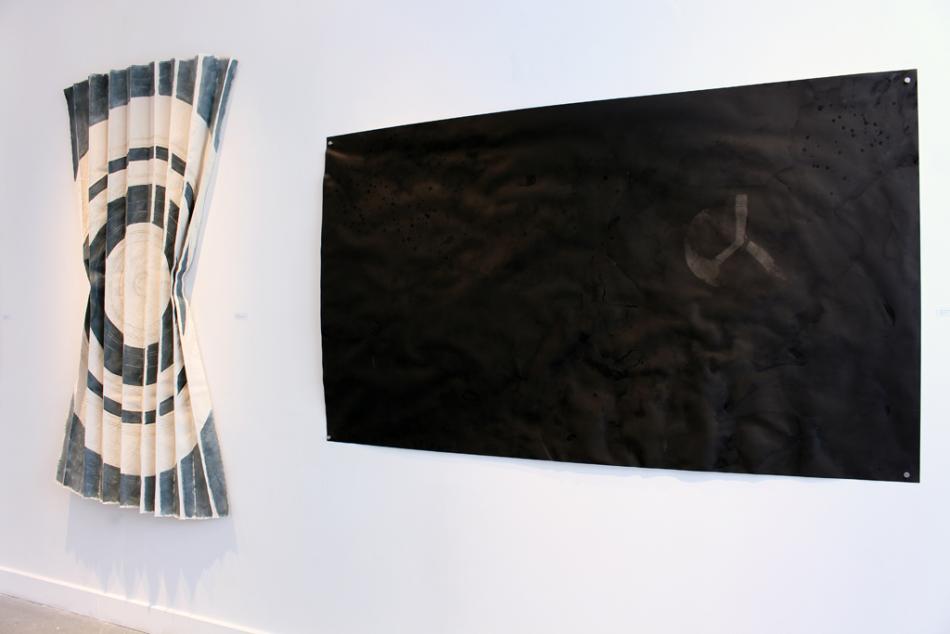Guidance
Bogdan Luca, Nancy Anne McPhee and Trudy Perks
-
Opening Reception: March 25, 2:00 – 5:00 pm
Nancy Anne McPhee - Cotton Factory Talks: May 19, 7:00 pm at the Cotton Factory (270 Sherman Ave N. Studio 236 in the Storehouse Building - entrance through parking lot).
What results when an art work can guide itself? No longer determined solely by the hand of the maker or the circumstances of creation, accidents and flaws inevitably shape the outcome of a work. Is it a collaborative process with chance? An exploration in potential? Bogdan Luca, Nancy Anne McPhee, and Trudy Perks each allow material process to guide and surprise them in the creation of their work. Luca’s mixed media paintings combine collage, abstraction and figurative representation into a liminal field that evokes the ambiguity and shifting identities of the subjects he portrays. At times, a comment on how societal contexts and mass media can effect a shifting sense of self, and the power relations at play. McPhee’s ink washes juxtapose satellites against the vastness of space. These large-scale drawings exemplify the willfulness of the materials used, ink running and collecting into chance constellations. Simultaneously, the viewer is asked to ponder the resulting sense of loneliness, and, at the same time, the mass surveillance evoked by these satellite images. Inspired by NASA re-entry parachutes, Perks’ subtle textural canvases evolve into soft structures evidencing mark making, the relational history of a body being moved, and the canvas’ response. As demonstrated by the works on display, when expertise can lead to a predictable outcome, a willingness to relinquish control can allow for the development of new approaches, pathways, ideas, and connections.
This exhibition is accompanied by a critical essay written by Benjamin Prus which can be found below.
Nancy Anne McPhee - Cotton Factory Talks: April 29, 2:00 pm at the Cotton Factory (270 Sherman Ave N. Studio 236 in the Storehouse Building - entrance through parking lot). As the most recent artist in residence of the Hamilton Artists Inc. Cotton Factory Residency Program where she created the majority of the works on display, McPhee will talk about the process of these images as well as about her broader exhibition practice.
Bogdan Luca is a Toronto based artist interested in the ecology of images that constantly shapes our consciousness and sense of reality. Bogdan uses painting, drawing, collage, and photographic techniques to create images that reflect a sense of contemporary disorientation in relation to an over abundance of visual information. He has shown his work in Canada, Romania, Germany and the US. Bogdan also teaches drawing and painting at OCAD University and the Art Gallery of Ontario.
Nancy Anne McPhee is a textile installation artist originally from Alberta and now based in Hamilton, ON. McPhee has a BFA from the University of Victoria, an MFA from Concordia University, an MLIS from Dalhousie University, and has worked as an instructor at Concordia University and NSCAD University. McPhee has exhibited nationally and internationally in commercial galleries, artist-run centres and public galleries, and has received funding from the Canada Council, the Ontario Arts Council, and the Conseil des arts et des lettres du Québec. Recent exhibitions include the Biennale internationale du lin de Portneuf (QC), SUPERCRAWL Hamilton (ON), and upcoming solo shows at Agnes Jamieson Gallery (ON) and Grenfell Campus Art Gallery (NL).
Trudy Perks is a painter living in Barrie, Ontario, making work about folds. She is interested in the emergence of patterns and soft structures with flexible geometries. Her work often references physics and nature, questioning limits of authority and what is considered traditionally feminine. She grew up in Southern California and has a BFA from OCAD University (drawing and painting, 2016) and Hon.B.Sc. from the University of Toronto (physics and environmental studies, 2000). She also studied at Loughborough University’s School of Art & Design in East Midlands, UK (studio practice, 2010). Awards received include scholarships from the Women’s Art Association of Hamilton, OCADFA and Loughborough University School of the Arts. She has exhibited recently in Midland, Orillia, Barrie and Toronto, Ontario, and in Florence, Italy.
“If I do this, will you do that?”
Marcel Duchamp, in an address given to the American Federation of the Arts in April, 1957, titled “The Creative Act,” declared artists and spectators the “two poles” in art's creation (138). While the artist produces the work, it is the spectator who brings the work to the broader world through aesthetic interpretation. For Duchamp, viewers of art find the “art coefficient” in works, the quality that causes any object to “change from inert matter into a work of art” (139). But in this transubstantiation from mere matter into art, does material affect our experience? Rather than resting in a realm of inertia, in what ways does matter claim voice within the creative act? Bogdan Luca, Nancy Anne McPhee, and Trudy Perks each allow material process to guide and surprise them in the creation of their work, suggesting a triumviral rather than a polar structure in the creative act.
Bogdan Luca exhibits large paintings from his series “The Inner Life of Images.” Luca’s mixed-media paintings evoke the cool assuredness and awkward anomie of postmodern displacement, effortlessly swapping printed materials for paint. Inspired by the image flotsam of our contemporary moment, these works suggest an embodied reality in constant flux. Luca’s handling of his material echoes the shifting identities of his subjects. The works’ hues are left deep, as if the paint should speak for itself. Areas of high contrast cause the eye to flit itinerantly within the image, never resting for long. The collaging of found photographic elements within the paintings robs the works of opportunities to give the viewer moments of intimate detail, while at the same time evoking the ever-changing social masks worn in different contexts. The contrasting visual languages of these starkly rendered areas give the images a painterly quality, using both acrylic and oil paints to achieve a looseness reminiscent of the Bay Area Figurative Movement combined with the edgy drips and bright palette of Peter Doig or Kim Dorland. Encouraging and provoking accidents caused by the material, Luca writes, “I want my work to surprise me, I don't want to know what it will look like.” This lucrative looseness allows his subjects to occupy a liminal space between the corporeal and ephemeral—the phenomenal field of our mediated existence.
In a similar looseness, the happy accidents of Nancy Anne McPhee’s large-scale ink-wash drawing of the NASA Juno satellite orbiting Jupiter populate the expanses of space. In this new work from her Satellites series, areas of drying and blotting form random constellations of stars, allowing the depth and vastness of the black field of space to envelope the viewer. The accidents and flaws inherent to working with ink wash on a large scale energize the work with chance and material potential. McPhee transposes the positive and negative space of the image, leaving the satellites delineated by vacuous bars of the support, while the nebulous shapes of “empty” astronomy take centre stage. McPhee writes, “Working with ink wash is always dependent upon luck, speed and chance,” and it is this exploratory quality of the unknown that informs her subject matter—vast, indeterminate, empty spaces and the accidents of discovery. The large scale of McPhee’s material proclaims internal influence between artist and viewer within the creative act.
Trudy Perks treats canvas as structural material. In her current series of folded paintings, loose geometric patterns emerge from the chaos of chance manipulation. These large-scale cotton canvas works are folded, ironed, painted, and drawn onto with acrylics, watercolour, and metallic leaf. Though guided by the repetitive use of mathematical constants memorized through a previous interest in physics, Perks’ artistic practice gives great voice to her disorderly material collaborator, the canvas. Directed by the movement of the folded fabric and its responses to manipulation, Perks works in what she calls “a slow call-and-response type of process between myself and the canvas.” Gradually a soft structure emerges from this dialectical method. Along with her material, Perks gives equal footing to the viewer, where these large wall-tapestries cause the spectator to dance to-and-fro to gain multiple vantagepoints. While the onlooker remains active, the folds and creases of the paintings appear as scares, visible traces of growing pains gently suspended in time. They evince the third dimension, not only structurally but symbolically, as well, as their tender bodies speak volumes as the third members of the triumvirate creative act.
Perks asks of her material, “If I do this, will you do that?” Luca, McPhee, and Perks guide their practice in this inquisitive way. Their interlocutor, collaborator, and partner in this endeavour is the matter with which they work.
—Benjamin Prus
Cited: Duchamp, Marcel. "The Creative Act." 1957. The Writings of Marcel Duchamp. Michel Sanouillet and Elmer Peterson, eds. New York: Da Capo, 1973. 138-140.
